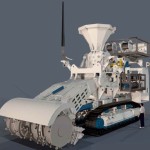Nautilus Mining is the virus that will not go away. You have to admire their persistence if it did not come with destruction of deep-sea ecosystems.
Nautilus Minerals estimated in a September 2009 corporate presentation that “thousands of underwater sulphide systems [hydrothermal vents] exist,” and “if only half of underwater systems are geographically viable, seafloor production would represent several billion tons of copper per annum.”…In a review paper published June 23 online in the journal Mineralium Deposita, Cathles, Cornell professor of earth and atmospheric sciences, writes that while land-based deposits may be a dwindling source of valuable minerals, deposits on the ocean floor could power humanity for centuries…Little by little, mining companies are working their way through the international laws, committees, and bureaucracies in order to try out some of the advanced undersea technologies that are being developed. via Tapping the Oceans Mineral Wealth With Deep Sea Mining | Oil Price.com.
- Seafloor mining would create sediment plumes that would smother organisms relying on filter feeding.
- Removal of hydrothermal vents, even extinct, could potential expose non-vent organisms to toxic levels of heavy metals. These species, unlike those occurring at vents, are not adapted for this exposure.
- Mining operations are not delicate processes and as such unintentional destruction of nearby habitats is likely. In my experience with one ton plus, remote operated vehicles precisions movements are often not possible.
- The economic incentive lies with continued and total removal of vent fields not with their protection. Will mining companies exercise discretion. Lessons from terrestrial mining indicate they will not.
Prior DSN posts about mining the seafloor
- NIOT will starts the next phase of fields trials at 1000m for deep-sea mining equipment
- Vents of gold
- Deep-sea mining workshop at Woods Hole
- A brief pardon for PNG deep
- Nautilus invests more money in mining
- Legislative reform needed to protect ocean floor from mining
- Nautilus moves to new phase (courtesy of Rick Macpherson)
- Everything you wanted to know about Nautilus Mining
- The new ‘gold rush’ off Africa
- Is PNG for sale? Tribal villagers think so.
- How mining the ocean floor is good not bad
- DSN’s first post on deep-sea mining from 2007





